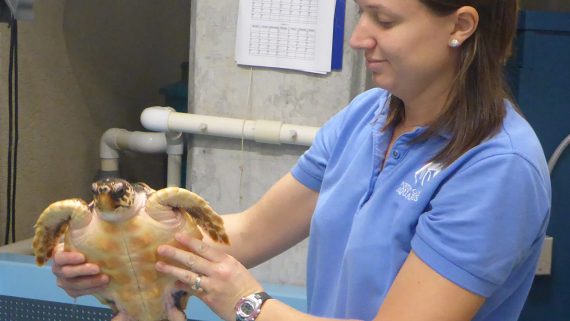A Holiday Season with Penguins, Sea Turtles, and Santa
The North Carolina Aquarium at Fort Fisher recently hosted some holiday guests for our Santa by the Sea event. Santa Claus, with his jolly demeanor and a sparkle in his eyes, was the main draw. He welcomed visitors, listened to children’s requests, and even dove in the Cape Fear Shoals. Some of his favorite animals include sea turtles, so he always makes a special trip to the Aquarium. Santa was also joined by some African penguins visiting from the Newport Aquarium in Kentucky.

Diving Santa in Cape Fear Shoals
African penguins are native to the rocky coastlines in southern Africa and are endangered. We may not automatically think of penguins and Santa going together since Santa’s North Pole workshop is located in the northern hemisphere while all 17 species of penguins are found in the southern hemisphere. However, Santa, penguins, and our very own sea turtles on the North Carolina coast are all facing challenges caused by climate change.

Simon, one of the African penguins visiting from Newport Aquarium in Kentucky.
Climate change is causing the planet to get warmer. As the temperature rises, reflective Arctic sea ice melts and the darker ocean beneath the ice absorbs more heat, making temperatures rise even more. This melting sea ice has already proven to be problematic for polar bears, which use the ice to hunt on. Santa may be impacted by the melting ice as well. At the very least, he may have to move his workshop to a sturdier surface or make sure it floats.
African penguins rely on baitfish for food. The penguins find the fish, like anchovies and sardines close to the shore. As ocean waters become warmer, swimming patterns of baitfish shift, pushing them farther away from the coast. African penguins now must work harder and expend more energy to find enough food for themselves and their chicks. Because more energy is needed and fish are harder to find, these penguins are facing challenges to their survival.
We may be a long way off from the North Pole and the African coast, but our native species of sea turtles face their own challenges associated with climate change. The gender of a sea turtle hatchling is temperature dependent. Lower temperatures during incubation usually produce males and higher temperatures produce females. In addition, as the planet warms overall, record temperatures are being documented.Temperatures ranging from 79° F to 89.6° F are safe for sea turtle hatchlings. Temperatures higher than that range, even for a short period, can be lethal.
We can all help Santa keep his favorite animals safe by doing things a bit differently this holiday season. Instead of buying gifts for friends and family members, you can make gifts for them by reusing things you already have. How do reusable items help African penguins and sea turtles? When you reuse things, you are helping lower the demand for disposable stuff, like plastic. Making less stuff like plastics means that fewer fossil fuels are burned. When fewer fossil fuels are burned, less carbon dioxide (CO₂) is emitted into the atmosphere. Less CO₂ in the atmosphere means less warming. And less warming keeps the North Pole and the ocean cool and stable, helping Santa, penguins, and sea turtles!
Find out more about African penguin conservation projects here. Our hatchlings are growing fast! Turtle A is now 383 grams and 12.7 cm long, while turtle B is 359 grams and 13.3 cm long. See their entire growth journey by going here. Find out how to use these measurements in your classroom by looking at this lesson plan.








